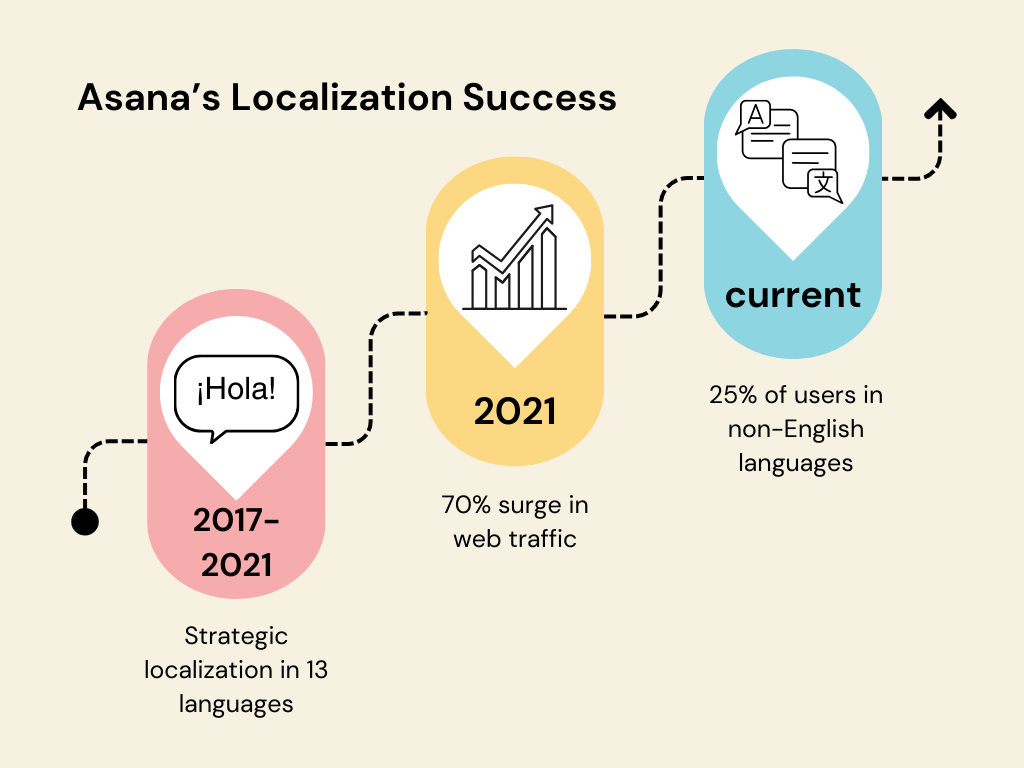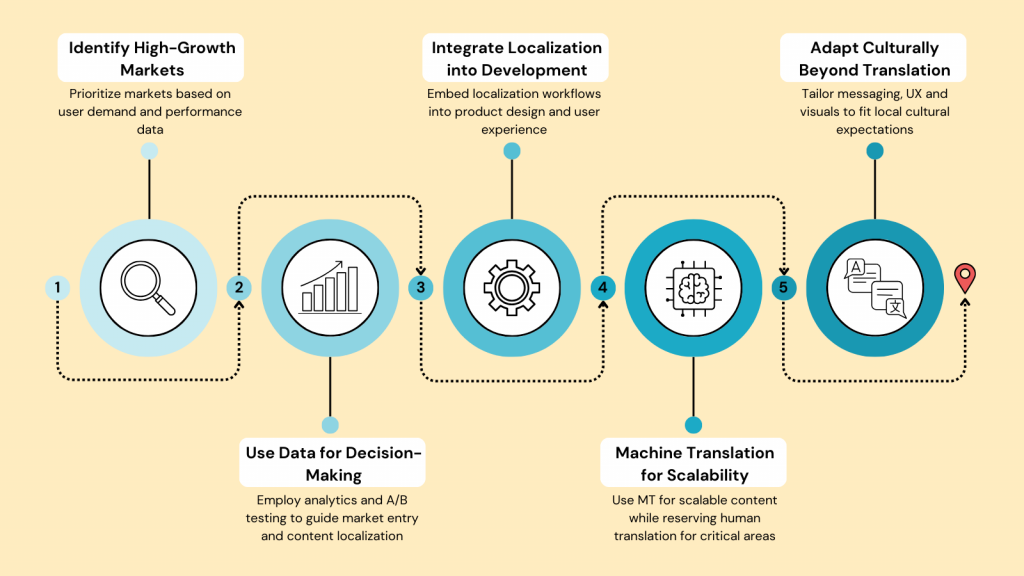Here’s the deal – expanding your SaaS platform globally isn’t just about running a few ads and counting on everyone understanding English. If you want users in new markets to actually love your product (not just tolerate it), you need a software localization strategy that makes your platform feel like it was built just for them. Seamless, intuitive, native.
Believe it or not: companies that invest in software localization see a 20%-30% revenue boost (Nimdzi). But you can’t just shoot in the dark here. You have to scale with purpose.
Take Asana, the work management platform we all know and love. They didn’t just translate their product and call it a day – they strategically localized their content, marketing, and user experience to fuel massive global adoption and skyrocket web traffic. Their approach is a blueprint for any SaaS company looking to scale internationally without losing relevance.
In this article, we’ll break down why software localization is a game-changer for SaaS growth and how you can steal Asana’s playbook to expand your global reach.
Why Software Localization Is a SaaS Growth Engine
Let’s bust a myth: English alone isn’t enough. Sure, it’s a great starting point, but did you know that less than half of internet users speak English? That means if you’re not localizing, you’re leaving a massive audience untapped – and a lot of money on the table.
SaaS localization is a growth accelerator. When done right, it removes friction, improves engagement, and makes your software feel like it was built for every user, no matter where they are. Companies that prioritize localization reach more users, but even more importantly, they acquire and keep them at a much higher rate.
Asana’s success isn’t a fluke; it’s proof that making localization a strategic priority pays off. Here’s why you can’t afford to overlook it:
Market Penetration: Hello, New Revenue Streams
No matter how amazing your software is, if users can’t navigate it in their language, adoption will be sluggish. Research shows 76% of online consumers prefer products in their own language – and SaaS users are no different. A localized software experience removes barriers to entry, makes onboarding effortless, and boosts retention. The easier it is to use, the more likely users are to stick around, upgrade, and recommend your product.
Better Customer Experience: Trust Comes in Translation
Software localization is more than translating words on the screen – it’s about translating the whole experience. Make it effortless. No one wants to struggle through clunky translations or guess whether a price is in USD, Euros, or Yen. A well-localized SaaS product eliminates these roadblocks, making it easy and intuitive for users to engage.
Competitive Edge: Stand Out in Crowded Markets
The SaaS world is cutthroat. Localization is your secret weapon to differentiate yourself. Users will always choose software that speaks their language – literally and figuratively – over one that forces them to adapt. By localizing, you send a clear message: “You matter to us, no matter where you’re from.”
Leveraging AI Translation Technology: The Right Mix of Speed and Quality
AI-powered machine translation (MT) makes software localization faster and more accessible, but AI translation alone isn’t enough. Critical areas like UI, onboarding, and marketing need human refinement. The best SaaS companies blend AI with human oversight to ensure:
- Scalability – AI speeds up translation efforts.
- Accuracy – Human linguists maintain brand consistency.
- Efficiency – A hybrid model optimizes costs while ensuring top-notch quality.
The Numbers: Software Localization Pays Off
The financial upside of software localization is undeniable. Every dollar spent on localization has the potential to deliver massive returns.
Some studies even suggest sky-high ROI figures – like the Equipe Consortium’s 2001 report claiming 1900% ROI on software localization investments. While results vary by market and strategy, one thing is clear: localization drives real business growth.
- Expanding into Spanish-speaking markets led to 2.2 million additional monthly web visits, fueling a 70% increase in overall web traffic over three years.
- 25% of Asana’s users now operate in languages other than English, with strong adoption in Japan, France, and Germany.
While exact ROI figures depend on your strategy, market, and execution, one fact stands: localization isn’t a cost – it’s an investment with potentially huge returns. Expanding into new markets and tailoring your product to local preferences strengthens customer satisfaction, brand loyalty, and long-term success.
So, the real question isn’t if localization pays off – it’s when are you going to start?
*No credit card or verification needed.
Software Localization: A Growth Driver, Not Just a Translation Task
You can’t just run your content through DeepL and call it a day. Unlike other industries where localization means tweaking a website or translating some marketing materials, SaaS companies need to go way deeper to penetrate markets. Localization has to be embedded into your software – from the UI and workflows to customer support and compliance policies – so everything aligns with local expectations without breaking the product experience.
And that’s where the real challenges begin.
Tackling localization isn’t for the faint of heart, especially in SaaS. Making your entire platform feel native to users across different markets is a daunting task. It means rethinking interfaces, workflows, user prompts, customer support content, and even legal agreements to fit seamlessly into each region.
A simple translation won’t cut it. Users should feel like the product was built for them, not just retrofitted after the fact. Here’s why localization is so tricky for SaaS companies – and why a solid strategy is a must-have:
Cultural Adaptation
A direct translation might be technically accurate, but that doesn’t mean it will resonate. The way people interact with software varies wildly across cultures – design choices, color psychology, date formats, and workflow structures can be completely different. What feels intuitive in the U.S. might feel clunky in Japan, Germany, or Brazil.
Solution: Conduct in-depth cultural research before launching in a new market. Work with local experts to refine UX/UI elements, adapt tone and messaging, and ensure your software aligns with regional norms and expectations. Prioritize user testing with native speakers to avoid cultural missteps and create a more intuitive, localized experience.
Technical Headaches
Before you even think about localization, your software needs to be internationalization-ready. That means your code must support multiple languages, scripts, currencies, right-to-left (RTL) text, etc. Formatting, UI responsiveness, and integrations need to function smoothly across languages – a nightmare if you didn’t plan for it from the start.
Solution: Bake localization into your growth strategy from day one. Start with internationalization – structuring your code to support multiple languages, scripts, currencies, and right-to-left (RTL) text ensures expansion won’t break the user experience.
Data-Driven Decision Making
Guesswork won’t get you far. SaaS companies need to analyze real-world data – traffic trends, user demand, revenue potential, and SaaS adoption rates by region – to prioritize high-impact markets. Without clear localization KPIs, you risk wasting resources on low-priority regions while ignoring real revenue opportunities.
Solution: Use data, not gut feelings. Analyze user engagement, organic traffic, and demand signals to determine where localization will have the biggest impact. Start small, optimize, and scale strategically.
Balancing Human and Machine Translation
AI-powered machine translation (MT) can handle volume, but it misses nuance – brand tone, context, and cultural sensitivities. Human translators bring quality, but they’re expensive and time-consuming.
Solution: Adopt a hybrid translation model. AI works well for large-scale content (FAQs, knowledge bases), but customer-facing and UX-critical content needs human oversight to ensure clarity, brand consistency, and cultural relevance.
*No credit card or verification needed.
Stakeholder Alignment
Software localization touches multiple teams – engineering, marketing, product, and customer support. If there’s no clear alignment on goals, budgets, and timelines, you’ll end up with delays, inconsistent messaging, and mismatched priorities.
Solution: Encourage cross-team collaboration. Localization isn’t just a marketing project – it requires tight coordination across departments to ensure a smooth, consistent user experience.
Market Research and Prioritization
Not every market deserves equal attention from day one. Expanding too fast, too soon can spread your resources thin and limit your success everywhere. A data-driven globalization strategy is essential to identify high-potential markets and focus your efforts where they’ll drive real traction.
Solution: Test, iterate, and improve continuously. Launching a localized software is just the beginning. Gather user feedback, run A/B tests, analyze engagement data, and tweak your approach to maximize impact.
How Asana Scaled Globally Through Strategic Localization
Asana is built to simplify workflows with automation, project timelines, and third-party integrations. Sounds like a winning formula, right? Not quite. Product features alone don’t guarantee global adoption. A truly successful SaaS product isn’t just functional – it’s accessible, culturally relevant, and intuitive in every language.
Recognizing this, Asana took a strategic, phased approach to localization, and it shows.
Asana’s Phased Approach to Global Localization (a.k.a Glocalization)
2017: Breaking into the Japanese Market
Japan was Asana’s first major localization push – and for good reason. It’s a high-demand market with low English adoption but strong SaaS penetration. To succeed, Asana went beyond translation, adapting their UI, messaging, and onboarding flows to give the Japanese business what they wanted. They prioritized cultural adaptation and in-depth user research, which helped them build trust and gain traction in a competitive, tech-savvy market.
2018: Expanding to Europe & Latin America
With momentum from Japan, Asana set its sights on Europe and Latin America, introducing French, German, Spanish, and Portuguese versions. But they didn’t stop at translating the interface – they localized marketing campaigns, customer support, and in-product messaging to provide a native-feeling experience for users in each region.
2021: Scaling with Eight More Languages & Content Localization
By 2021, Asana was ready to level up. They expanded into eight additional languages – Chinese, Russian, Swedish, Indonesian, Italian, Korean, Polish, and Dutch – using data-driven insights to identify high-growth regions.
At this stage, they realized that software localization wasn’t just about the product. Users needed to find and engage with Asana in their own language. The team shifted its focus to SEO-driven content localization, adapting long-form blog posts, marketing materials, and landing pages to boost search rankings and audience engagement. They managed to strengthen their inbound marketing reach and drive higher conversions by tailoring their content strategy to each region.
2022-2023: Investing in AI-Powered Content Localization
To keep up with demand, Asana integrated AI-powered translation tools, allowing them to scale content localization efficiently. However, they didn’t rely on automation alone – human oversight was still needed for brand consistency and UX quality, especially for critical content like UI, onboarding, and support documentation.
2023-2024: Regional Product Adaptation
Asana moved beyond just translating and localizing – they started customizing their product for different regions. This meant:
- In Asia, deeper integrations with popular local tools like WeChat Work and LINE.
- In Europe, a stronger focus on GDPR compliance and enterprise security.
- In Latin America, adjustments to pricing models and onboarding flows to cater to SMBs.
2024-2025: Expanding into New High-Growth Markets
By 2025, Asana continues its data-driven localization strategy and fine-tuning its regional approach. Key priorities include:
- AI-assisted content adaptation, ensuring translations stay true to Asana’s brand voice.
- Stronger regional partnerships, helping local businesses integrate Asana more seamlessly.
- Localized community building and fostering regional user groups and customer success programs to encourage long-term adoption in non-English-speaking markets.
The Software Localization Blueprint for SaaS Companies Looking to Scale Globally
Too many SaaS companies treat localization as a cost instead of a growth driver, rolling it out reactively rather than integrating it into their core expansion strategy. That’s a mistake. Localization, when done right, isn’t just about translating content – it’s about unlocking new markets, driving adoption, and boosting revenue.
While many SaaS companies struggle with rushed or fragmented localization efforts, Asana took a measured, data-driven approach, allowing them to expand strategically without sacrificing quality. Every localization investment had a clear, measurable impact – and that’s exactly how you should approach it.
Here’s what you can steal from Asana’s playbook to scale your SaaS globally:
1. Start Small, Then Scale - Take a Phased Market Entry Approach
Don’t localize everything at once. Prioritize high-growth markets based on user demand and performance data. Asana did it right by first focusing on Japan, then expanding to Europe and Latin America. This phased approach lets you optimize resources, refine processes, and build momentum from early successes.
2. Let Data Drive Every Localization Decision
Software localization is as much about hard numbers as it is about language. Asana doesn’t localize based on assumptions; they rely on analytics, market research, and A/B testing to determine:
- Which regions to enter first based on traffic and demand.
- What content needs localization first (UI vs. marketing materials).
- How to refine translations based on real user engagement.
3. Make Software Localization a Core Part of Product Growth
Localization is more than a marketing initiative. It should be embedded in your product development. Build localization workflows into your product design, onboarding, and user experience from the start. That means:
- UI adaptation that feels natural to each region.
- Multilingual support that scales as you grow.
- Localized SEO & marketing strategies that drive real organic traffic.
4. Use Machine Translation (MT) for Scalability - But Be Smart About It
You don’t need human translators for everything. High-touch content like UI and onboarding flows should have human oversight, while AI-powered machine translation can scale support content efficiently. Balance speed with accuracy.
5. Go Beyond Translation - Embrace Cultural Adaptation
Asana doesn’t just translate words, and neither should you. To connect with users properly, tailor your messaging, UX, and visuals to fit local expectations.
- Adapt language nuances to sound natural.
- Customize design and layouts for each region.
- Make sure your software feels native, not translated.
*No credit card or verification needed.
Never Stop Improving: Use Customer Feedback to Refine Software Localization
One of the biggest reasons Asana’s localization strategy works? They listen to their users. SaaS localization isn’t a one-and-done project, but an ongoing process that thrives on real customer input. The best SaaS companies iterate and make sure their localized content stays relevant, intuitive, and growth-driven.
So, how do you get the right insights? Here are three of the most effective ways to collect localization feedback:
In-App Feedback Tools
Pop-ups, rating prompts, and surveys let users flag translation errors, unclear instructions, or UX/UI issues in real time.
Customer Support Insights
Support tickets and chatbot interactions reveal common localization pain points – confusing terminology, unclear error messages, or missing language support.
Social Media & Community Monitoring
Users openly discuss product frustrations on platforms like Reddit, LinkedIn, and X (Twitter). Monitoring these conversations can help uncover language inconsistencies, UI complaints, and cultural adaptation gaps.
By actively listening to global users and iterating based on their feedback, you make your localized experiences not only functional but also engaging, intuitive, and built for long-term success in every market.
Final Thoughts: Scale Like Asana - Localize for Growth
Asana’s success proves that SaaS localization isn’t just a nice-to-have – it’s a growth engine. By localizing not just their product, but also their website and marketing, they boosted adoption rates, improved engagement, and built stronger customer relationships worldwide.
For SaaS companies eyeing international growth, the message is clear: localization is an investment in long-term success. It fuels higher customer satisfaction, brand loyalty, and revenue growth in competitive global markets.
Ready to take your software across the borders? Taia can help you develop a tailored software localization strategy and help your SaaS product succeed in new markets.
Frequently asked questions
What is software localization?
Software localization is the process of adapting a product’s language, UI, and user experience to make it feel native in different markets. It’s different from mere translation – it’s about adjusting date formats, currencies, design, compliance requirements, and even cultural nuances to provide users in each country with a seamless experience.
Why is software localization important for SaaS companies?
Because users expect products in their own language. Over 76% of people prefer software in their native tongue, and companies that localize see higher adoption rates and better user retention. Without localization, SaaS businesses risk alienating entire markets before they even get started.
What’s the best tool for software localization?
A good software localization tool should do more than just translate – it should offer a hybrid approach, combining AI-powered machine translation with expert human translation to ensure both speed and accuracy.
At Taia, we provide AI-driven localization solutions with human oversight, ensuring that your software is not just translated but perfectly adapted for each market. Our platform supports 72 file types, machine translation that learns from your translation memory, and real-time project management, making scaling into new markets faster, more efficient and affordable.
How do you build an effective software localization strategy?
If you’re serious about scaling globally, you need a solid localization strategy. Here’s how to do it right:
- Do your research first – Figure out which markets offer the biggest growth potential.
- Prioritize key languages – Start with the languages that bring in the most users or revenue.
- Use a hybrid localization approach – Combine AI-powered translation with expert human translators to scale faster without sacrificing quality.
- Integrate localization into your development cycle – Don’t treat it as an afterthought, but make it part of the product roadmap.
- Track performance & optimize continuously – Localization is a living process. Measure impact, collect user feedback, and refine as needed.
What are some great examples of software localization?
The best SaaS companies localize their software strategically and sustainably. Some of the best software localization examples include:
- Asana – Phased market entry, regionalized marketing, and cultural adaptation.
- Netflix – Custom subtitles, dubbing, and UX tailored to each region.
- Shopify – Localized checkout experiences, currency support, and region-specific integrations.
How does the software localization process work?
Think of localization as a four-step process:
- Internationalization (i18n) – Prepping your software by separating text from code so it can be easily adapted to new languages.
- Translation & adaptation – Converting content while adjusting for cultural and technical differences.
- Integration & testing – Making sure translations fit the UI and don’t break functionality.
- Ongoing optimization – Updating translations and improving based on user feedback and market needs.
How do you effectively manage a software localization project?
Managing localization can feel overwhelming, but breaking it down into clear steps helps:
- Set goals based on user data & demand – Decide which markets to prioritize and define your localization success metrics.
- Build a localization team – Assign roles for project managers, linguists, and developers.
- Use the right tools – A TMS (Translation Management System) like Taia keeps everything organized.
- Test before launch – Run localization QA checks to ensure everything works in the new language.
- Continuously improve – Gather user feedback and refine your translations over time.
Taia Translations can provide all of the above for you. We can:
- help you define your target markets
- assign a team including a dedicated project manager, translators and support
- localize your software using a hybrid approach – Machine Translation (MT) + human expertise
- run tests before delivering the final translation
- provide you continuous support for optimization
What are the biggest challenges in software localization?
SaaS companies often run into:
- Cultural adaptation issues – Translations that don’t feel natural or fail to align with local norms.
- UI and technical constraints – Some languages take up more space (looking at you, German), while others require right-to-left formatting (Arabic, Hebrew).
- Scaling efficiently – Managing multiple languages across frequent product updates can be a nightmare.
How to solve them
- Test early, test often – Run localization QA before launching in a new market.
- Leverage AI + human translators – Speed up the process while maintaining accuracy and cultural relevance.
- Plan for text expansion – Build flexible UI designs that accommodate different text lengths. That’s also called internationalization (i18n).
How can I collect user feedback in software localization?
The best way to improve software localization is to listen to the people using it. Users will tell you – directly or indirectly – where things feel off. Here’s how you can tap into that feedback:
1. Use In-App Feedback Tools
Let your users report any issues and give feedback inside your software. A simple “Report Translation Issue” button or an in-app rating system should do it so users can flag mistakes on the spot. The easier you make it to give feedback, the more insights you’ll collect.
2. Analyze Customer Support Tickets
Your support team is sitting on a goldmine of localization feedback – they hear firsthand when users are frustrated by unclear instructions, weird wording, or untranslated sections.
3. Monitor Social Media & Online Communities
Users talk. A lot. And if your localization is off, they’ll vent about it on Reddit, Twitter, LinkedIn, and local forums. Keeping an eye on these conversations can give you unfiltered, real-world feedback – sometimes even before it reaches your support team.
What’s the difference between software localization and translation?
While translation focuses on converting text from one language to another, localization goes deeper. It adapts design, formatting, compliance, and cultural tone to make a product feel like it was built for that market.
What’s the difference between software internationalization, localization, and globalization?
These terms often get mixed up, but they play different roles:
- Internationalization (i18n) – Prepares software to support multiple languages without requiring major code changes.
- Localization (L10n) – Adapts the product for a specific market, including language, UX, and compliance.
- Globalization (G11n) – The broader strategy of expanding into international markets, covering both localization and internationalization.
Think of it this way: Internationalization sets the foundation, localization customizes the experience, and globalization brings it all together for worldwide success.






